|
|
|
Sort Order |
|
|
|
Items / Page
|
|
|
|
|
|
|
| Srl | Item |
| 1 |
ID:
129007
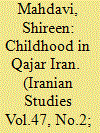

|
|
|
|
|
| Publication |
2014.
|
| Summary/Abstract |
The history of children in general and that of Persian children in particular is that of the inarticulate. The social history of Iran is a neglected field although in recent decades a preponderance of material has appeared on the history of women. Aside from this no work has been undertaken on the private life of the period including childhood and family life. This article examines various aspects of the position and upbringing of children in Qajar Iran ranging from the rearing of children to their status in the family, discipline, amusements and education. This investigation attempts to cover the childhood of different sexes and social classes both in rural and urban areas. The discussion is limited to Shi'i children, the majority population of Iran.
|
|
|
|
|
|
|
|
|
|
|
|
|
|
|
|
| 2 |
ID:
106070


|
|
|
| 3 |
ID:
102708


|
|
|
|
|
| Publication |
2011.
|
| Summary/Abstract |
This paper is based on an earlier one about James Baillie Fraser's trip to Khorasan in the 1820s, the first European to travel there in the Qajar era. But instead of focusing on Fraser's experience, the information given by him is used to view the circumstances in Khorasan from an Iranian perspective, which, in turn, is derived from a study of the three main categories of people met by Fraser. Through them and their careers, the paper analyzes the problems, both inherited and new, that the early Qajars faced from the outset. Each of the three categories is dealt with separately under the headings of Prince-Governors, Princes in Exile or in Obeisance and, finally, High Priests. Together these complete the overall picture in Greater Khorasan and, by extension, throughout Iran at that particular time. What emerges from a study of their careers are the seeds of some of the major trends that were to mark nineteenth-century Iran. Khorasan, with its size and position, was particularly well placed to afford a view of a society still dependent on tribal vagaries and the dominant role of the religious hierarchy. Above all, the geo-strategic location of the province affords a privileged view across to the outlying parts of Greater Khorasan which, although still viewed from inside as a part of Greater Iran, were, due to inherent instabilities, liable to manipulation by British and Russian imperialism. The most effective tool of the latter was a propensity to promote new national entities on the ruins of an empire struggling to sustain itself without means and with a dated mindset of which most people were sorely unaware. By projecting the circumstances of time and place onto the future, one can perceive a certain degree of inevitability in the upcoming history of Qajar Iran.
|
|
|
|
|
|
|
|
|
|
|
|
|
|
|
|
| 4 |
ID:
142762
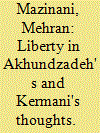

|
|
|
|
|
| Summary/Abstract |
Here I examine the modern idea of liberty in works of Akhundzadeh and Kermani – two leading Iranian intelligentsia under the Qajar Iran (1794–1925). In doing so, first, I set forth a brief (intellectual) background that shows some of the influences of Iranian, Russian, and European scholars on Akhundzadeh and Kermani. Then, their thoughts will be represented systematically by following a simple theoretical framework driven from their works. Applying one model to both cases particularly helps to demonstrate their similarities and differences, as well as how fundamentally different was their understanding of liberty from their contemporaries. To Akhundzadeh and Kermani, life under the Qajars resembled the lawless state of nature, transcending which, however, required more than establishing laws. For the transcendence to occur, a revolution in mind was needed; and for that matter to happen, liberty was a critical prerequisite and consequence.
|
|
|
|
|
|
|
|
|
|
|
|
|
|
|
|
| 5 |
ID:
111189
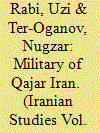

|
|
|
|
|
| Publication |
2012.
|
| Summary/Abstract |
The article examines the parameters of the irregular army in Qajar Iran, including its assembly, numbers, and provisions, as well as the army's organizational structure: its administration and the divisions of the ad hoc forces (provincial militia and tribal cavalry) and of the standing forces (the shah's bodyguard and artillery corps). Until the creation of the so-called regular army units in Iran at the beginning of the nineteenth century, the irregular army was regarded as the only military force in the service of the Qajar dynasty. Despite the existence of a "regular army," irregular forces, particularly tribal cavalry, continued to play a significant role in Iran's military system throughout the nineteenth century. By understanding the features of the irregular army-its role in Qajar society, its organizational and social structures, its ethnic composition, and other characteristics-we can better understand the character of the state itself.
|
|
|
|
|
|
|
|
|
|
|
|
|
|
|
|
| 6 |
ID:
177803
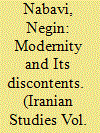

|
|
|
|
|
| Summary/Abstract |
The ratification of the Press Law in February 1908 marked a significant development in the history of censorship in Iran. However, in the little that has been written on this subject, the Press Law has been explained primarily in terms of constitutional politics, and the pressure that the first majles was put under by royalist forces who had been upset at the critical and anti-royalist tone of constitutional newspapers. This article takes a different approach; it contextualizes the Press Law and evaluates it in light of the attempts at control that had been put into effect by the state in the pre-constitutional years. To this end, this article considers the largely untold story of censorship in Qājār Iran. How did the understanding of what censorship should entail evolve through the years? How was censorship exercised, and what challenges did censorship pose for both the authorities and the subjects in the Nāseri and Mozaffari eras, culminating in the Press Law in February 1908?
|
|
|
|
|
|
|
|
|
|
|
|
|
|
|
|
| 7 |
ID:
115020


|
|
|
|
|
| Publication |
2012.
|
| Summary/Abstract |
In the late nineteenth century, Qajar Iran, like its neighbor the Ottoman Empire, faced the dual challenges of colonialism and modernity. This paper considers the role of art education and art production in its response to these forces, focusing on the leading court painter of the late Qajar period, Mirza Muhammad Ghaffari, Kamal al-Mulk (1848-1941), whose career bridged the late Qajar period and the early twentieth century. Early in his career, Ghaffari was recognized as the leading exponent of academic painting, yet by the constitutional period his art had evolved into a style representing contemporary Persian life, a style which was informed by nationalistic discourses current in intellectual and political circles. This paper's consideration of the evolution of his style from a European modernism to an authentic Iranian modernism includes Ghaffari's training as a painter, the role of photography in the development of his style, his travel to Europe, and parallels with the art and career of the Ottoman painter Osman Hamdi.
|
|
|
|
|
|
|
|
|
|
|
|
|
|
|
|
| 8 |
ID:
164902
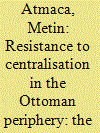

|
|
|
|
|
| Summary/Abstract |
Modern Kurdish historiography, which examines resistance to provincial centralisation in Ottoman Kurdistan, focuses largely on Bedir Khan’s Bohtan emirate and his revolt in the 1840s, while ignoring the rest of the other Kurdish emirates such as Baban emirate. While both states, Qajar Iran and Ottoman Empire, were endeavouring to solve their conflicts in the 1840s (a process which culminated in the treaty of Erzurum in 1847) the future of the Baban emirate and its territories emerged as one of the major issues during the course of negotiations. The Baban emirate was the last emirate to give up its struggle against the Sublime Porte’s centralisation reforms. The legacy of the Kurdish emirates is important to understand better the relations between the centre of the Ottoman Empire and its eastern periphery, a much less studied subject in Ottoman historiography. This article will highlight the impact of the centralisation policies in Kurdistan, more specifically on territories of the Bohtan and Baban emirates. It will be demonstrated that the changes wrought by the Tanzimat reforms were partially successful in transforming the Kurdish notables, who later became a part of the state bureaucracy. However, the reform-minded officials, who were appointed after the Kurdish emirs were removed from the region, failed to persuade the locals in favour of the new administration thus transforming their lives.
|
|
|
|
|
|
|
|
|
|
|
|
|
|
|
|
| 9 |
ID:
103456


|
|
|
|
|
| Publication |
2011.
|
| Summary/Abstract |
European merchants and investors doing business in the Middle East during the long 19th century expected that commercial disputes in mixed cases would be conducted according to procedures and laws familiar to and accepted by them. In the Ottoman Empire and Egypt, mixed courts based on the French commercial code were established during that century. The Qajars, however, offered the foreign commercial community a different judicial institution: the local ka-rguza-r (agent) and his majlis (court). By the beginning of the 20th century, thirty-six ka-rguza-r offices operated in Iranian towns and harbors. Nevertheless, foreign (mainly British) merchants and their consuls complained bitterly that it was not an effective institution and that it clearly favored the local tujja-r (big merchants). They claimed that these defects meant huge financial losses to them. The Qajars viewed this institution and its functioning differently. It served their policy of discouraging foreign penetration, and it contributed to the competitiveness of the Iranian tujja-r in their struggle for commercial superiority.
|
|
|
|
|
|
|
|
|
|
|
|
|
|
|
|
| 10 |
ID:
120863


|
|
|
|
|
| Publication |
2013.
|
| Summary/Abstract |
This paper re-examines the causes of outbreak of Second Russo-Iranian War and the factors that played a role in its escalation into fully fledged war. The paper challenges the common perception that Qajar Iran played a major role in the outbreak of the war and proposes that the Qajar court took a defensive posture vis-à-vis aggressive Russian provocation originated in Tiflis and was merely reacting to it. The paper then examines policy differences between Tiflis and the court of St Petersburg as a contributing factor in the outbreak of the war. Finally, the paper examines two different and contradictory views of imperial Russia and its internal politics and military capabilities among Qajar Iran's decision makers during 1825-28. It is argued that the two perceptions eventually translated into two factions, each lobbying the shah for and against escalation of hostilities with Russia.
|
|
|
|
|
|
|
|
|
|
|
|
|
|
|
|
| 11 |
ID:
083188


|
|
|
|
|
| Publication |
London, Routledge, 2008.
|
| Description |
xi, 234p.hbk
|
| Series |
History and Society in the Islamic World
|
| Standard Number |
9780415421195
|
|
|
|
|
|
|
|
|
|
|
|
Copies: C:1/I:0,R:0,Q:0
Circulation
| Accession# | Call# | Current Location | Status | Policy | Location |
| 053831 | 955.04/FAR 053831 | Main | On Shelf | General | |
|
|
|
|
| 12 |
ID:
118790
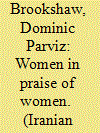

|
|
|
|
|
| Publication |
2013.
|
| Summary/Abstract |
This study examines the poetry of two women of nineteenth-century Iran-one royal, one non-royal-and the women patrons for whom they composed praise poetry. Through the reconstruction of female-centered patronage networks and associated female-only performance venues, and via an examination of the active roles played by female patrons both in affairs of state and in the management of the immense royal harem, this study highlights the various ways in which members of several generations of women in Qajar Iran were involved in the production, dissemination and appreciation of poetry. It is argued here that these patronage and poetry production networks should be read as evidence of a female-centered literary tradition, one that was in dialogue with (and often intersected) the dominant male tradition; one that empowered the women actors within it to create a sisterhood of poets through which their art could be passed on from mother to daughter, and from daughter to granddaughter (and occasionally from mother to son).
|
|
|
|
|
|
|
|
|
|
|
|
|
|
|
|
|
|
|
|
|